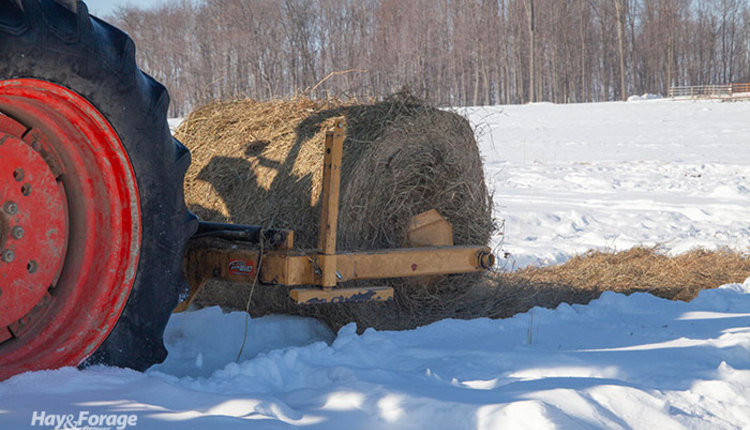
Feeding hay during winter is usually not up for debate. How hay is fed can and often should be.
When temperatures drop to single digits, feeding hay is not the sort of activity that draws people to enter the livestock production field. Yet, it has to be done. Things don’t get better in the spring when the frost leaves the ground and snow is replaced by rain. Over the years, farmers have devised different approaches to feeding hay. Some save labor, some reduce equipment use, and some do both. None are the right answer for every farm.
Recently, Canada’s Beef Cattle Research Council offered some pros and cons to three common winter bale-feeding strategies as listed below.
Traditional round bale feeder
Pros:
• Cattle consume a majority of the feed, leave less behind (“wasting” less)
• Lower cost than bale processing or rolling bales out due to reduced waste
• Less feed to maintain fat cover if hay has adequate nutrient density, as cattle are usually maximizing intake of what is fed
• Suited to any cattle class
• Easy access to cattle for monitoring or treating illnesses
Cons:
• Cattle have limited access to feed based on available bunk space, which can increase competition among animals
• Cost of bale feeders
• Required to start a feed truck/tractor for every feeding
• Increased time and financial cost to remove and spread manure if not moving feeding sites
• Mud can be a problem if hay is fed in the same location
• Cattle exercise less to consume feed, which can contribute to calving difficulties
• Snow removal may be necessary to support regular feeding activities
Rolling out bales on pasture
Pros:
• Cattle are required to travel more for feed, encouraging exercise, which may result in less calving difficulties
• Opportunity to move feeding location, which allows manure to be deposited more evenly, reducing manure management costs, and targeting areas that would benefit from nutrient deposition
• Flexibility with feeding sites
• Reduced competition due to increased access to feed
• Low input cost. Required equipment is likely already on farm
• Doesn’t require a lot of new knowledge or skills to implement
• Opportunity to monitor cow health before, during, and after feeding
Cons:
• Extra work to roll out bales rather than having them free-standing or in a feeder
• Cattle will eat some high-quality feed and use the rest as bedding. While this provides organic matter to the soil, in years when feed availability is low and cost is high, it is a significant loss. Loss can be remedied with portable bunks.
• Required to start equipment every feeding
• Winter conditions can cause forage loss/weathering
• Overprocessing (bale processor) can cause loss of nutrients if forage fines blow away
• Site options are strictly limited to locations with proper shelter and stock water (or adequate snow cover)
• Limited to mature cows in good condition
Bale grazing
Pros:
• Reduces or eliminates the need to remove/spread manure
• Can target sites to increase organic matter in areas that would most benefit in improved forage production
• Depending on size of grazing area, cattle may be required to travel more for feed, encouraging exercise, which may result in less calving difficulties
• More cattle can access feed at a time compared to rolling bales or using bale feeders
• Only requires a tractor once to set up fields; daily/weekly chores consist of moving fences
• Provides an opportunity to build a new skillset for feeding and managing cattle by extending the grazing season using bales
Cons:
• Cattle won’t fully clean up feed. While this provides organic matter to the soil, in years when feed availability is low and hay cost is high, try to minimize this loss.
• Managing net wrap or twine needs to be a priority
• There may be losses due to wildlife grazing
• Sites limited to areas with access to shelter and water
• May not be suitable for young or poor-conditioned cattle
• Requires preplanning to set up sites prior to the winter-feeding period
• Temporary fencing is required

